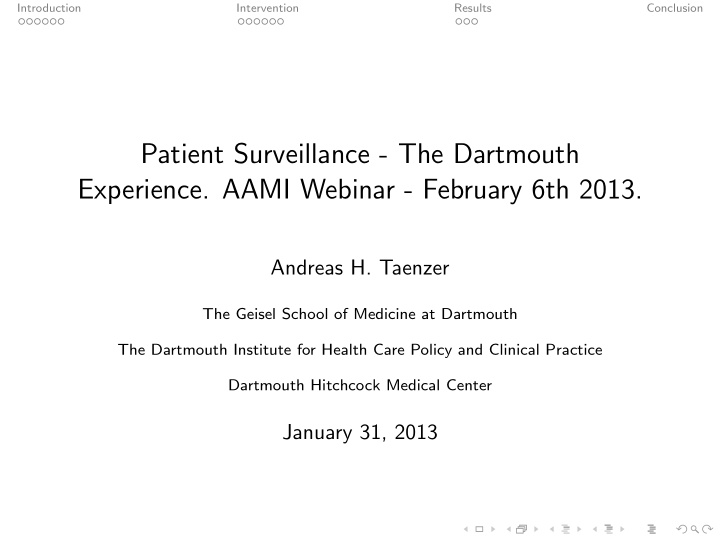



Introduction Intervention Results Conclusion Patient Surveillance - The Dartmouth Experience. AAMI Webinar - February 6th 2013. Andreas H. Taenzer The Geisel School of Medicine at Dartmouth The Dartmouth Institute for Health Care Policy and Clinical Practice Dartmouth Hitchcock Medical Center January 31, 2013
Introduction Intervention Results Conclusion Disclaimers Industry Products mentioned in this presentation: Patient Safety Net TM by Masimo Grants No compensation of any sort from any company (e.g. Masimo TM ). Grant from the Anesthesia Patient Safety Foundation to study respiratory rate monitoring for patients in general care areas. Salary support via an Innovation Grant from CMS to work on the High Value Health Care Collaborative’s Sepsis Project for The Dartmouth Institute for Health Care Policy and Clinical Practice Government grants (FDA, NIH) for unrelated research.
Introduction Intervention Results Conclusion Outline Dead in Bed No Death or Hypoxic Brain Injury since Dec 2007 in a 32-Bed Surgical Unit
Introduction Intervention Results Conclusion Outline Rescue Events per 1,000 patient days per month over 2 years. Control limits adjusted for time of Start of Patient Surveillance. 20 15 UCL=14.784 Patient Surveillance 10 UCL=5.889 5 CEN=4.564 CEN=2.5955 0 LCL=-0.698 1 2 3 4 5 6 7 8 9 10 11 12 13 14 15 16 17 18 19 20 21 22 23 24 -5 LCL=-5.657 -10
Introduction Intervention Results Conclusion Setting Dartmouth Hitchcock Medical Center 20,000 Inpatient Discharges 90,000 Inpatient Days 8,500 Intermediate Care Days 24,000 ICU Days
Introduction Intervention Results Conclusion Problem Definition and Intervention
Introduction Intervention Results Conclusion Problem Definition and Intervention Vocabulary Condition vs. Surveillance Monitoring Nuisance Alarms - Actionable Alarms Alarm Burden - Alarm Fatigue - Alarm Mismanagement Rescue Events = RRT activations + Code Blues + Codes Care Escalations/ICU Transfers = Unanticipated Transfer of a Patient to a Higher Acuity Care Unit
Introduction Intervention Results Conclusion Problem Definition and Intervention Goals Reduce adverse events No staffing changes Minimize burden on RNs
Introduction Intervention Results Conclusion Infrastructure
Introduction Intervention Results Conclusion Infrastructure over 12 x 10 9 data points over 50,000 patient days of physiologic data sampled in one-second intervals. for adverse event review and research
Introduction Intervention Results Conclusion Alarm Settings PSS Settings Alarm adjustments Alarm Settings 1 Standard Settings SpO2 < 80 2 Bracketed Adjustments ( ± 10%) by RN HR < 50 3 Physican ordered Adjustment HR > 140 Notification Delays 15 sec at the bedside +15 sec (=30 sec total) for pager annunciation
Introduction Intervention Results Conclusion Description of Normality SpO 2 Histogram Comparison HR Histogram Comparison 16 3 Medicine Medicine Surgery 14 Surgery 2.5 Proportion of Time Spent (%) 12 Proportion of Time Spent (%) 2 10 8 1.5 6 1 4 0.5 2 0 0 70 75 80 85 90 95 100 40 60 80 100 120 140 160 180 SpO 2 (%) HR (bpm)
Introduction Intervention Results Conclusion Description of Normality PSS Archive Plot 110 HR (bpm), SpO 2 (%) 100 90 80 70 60 50 18:00 00:00 06:00 12:00 18:00 Time Example of archived physiologic data for one patient.
Introduction Intervention Results Conclusion Description of Normality Case 122, supplemental O 2 on. Max length 3’, min drop 15%. 100 95 90 85 80 SpO 2 (%) 75 70 65 60 55 23:00 23:30 00:00 00:30 01:00 01:30 02:00 02:30 03:00 03:30 04:00 04:30 05:00 time SpO2 data of one patient over hours with repetitive desaturations (but no adverse event).
Introduction Intervention Results Conclusion Original Study Decrease of Rescue Events by 65%
Introduction Intervention Results Conclusion Original Study Decrease of ICU Transfers by 45% For each of the 32-bed surgical units, ICU days decreased by 160 for the 12 months after implementation.
Introduction Intervention Results Conclusion Original Study
Introduction Intervention Results Conclusion Summary DHMC has seen a sustained reduction in ICU Transfers and Rescue Events since the Introduction of Patient Surveillance despite an ever increasingly challenging patient population. Changes have been overall bigger on surgical than on medical units. The most important factor of success has been degree of utilization. 1 Collaborative effort by all stakeholders involved (Administration, IT, RNs, Physicians, Engineers etc.) 2 Education for RNs and physicians 3 Continuous monitoring on all surgical and medical units including pediatrics (and planned roll out to ER and OB) 4 Patients have to sign waivers to not be monitored
Recommend
More recommend